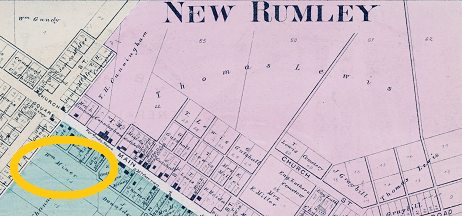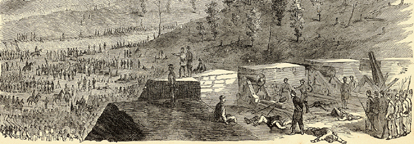
|
William
Miner |
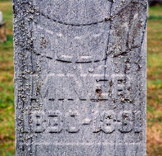 |
| United Brethren Church |
William Miner was born in 1830 in New Rumley, Harrison County, OH, the son of George and Susannah (Smith) Minard. He was a carpenter, and a veteran of the Civil War.
On Dec. 10, 1857, when he was 27 years of age, William was united in matrimony with 16-year-old Rachel Simmons (1841-1917), at the home of Frederick Kimmel, a local justice of the peace.
Rachel was said to be "one of those quiet women that nothing could be said against her." Kimmel’s son Henry once said he had known William "from boyhood until his death" and that as an eyewitness to the wedding of William and Rachel, "I fully recall the … manner in which they … joined hands and the position in which they were standing while the ceremony was being read by my father…." Kimmel's daughter Mary Ann would marry Jacob Minerd, and Kimmel's son Joseph would marry Catherine Minard.
William and Rachel together produced a family of two sons, John W. Miner and William Ellsworth Miner.
New Rumley has reached national fame as the birthplace of General George Armstrong Custer, and today the Custer birth site is an Ohio State Memorial. Circa 2001, there was a display at the memorial which exhibited an 1875 map of New Rumley. William’s name on his tract, as a property owner, is clearly marked on this map and display. (In fact, the Custers and Minerds were longtime neighbors and friends, and William's cousin Rebecca Minerd was romantically linked with Custer's brother, Capt. Thomas W. Custer.)
|
|
|
Above: 1875 Atlas of New Rumley, showing William's farm (circled). Below: detail showing the farm's proximity to Main Street and Church Square. |
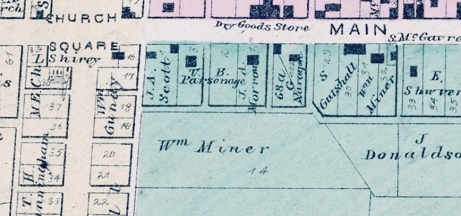 |
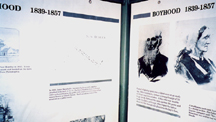 |
| New Rumley memorial with a map showing William's farm |
Prior to the war, William worked as a carpenter and is shown as such in the federal census enumeration of 1860. One of his employers was James Patton. Family friend Amanda Fisher recalled that William had labored for her family before the war: "Sometimes when he worked for my father he would not eat very much and claimed he was too tired to eat much. He was delicate looking and was not a rugged man."
As the Civil War was being waged, William enlisted in the Army on Feb. 19, 1864, and was assigned to Company G of the 74th OH Infantry. When he entered the Army, one soldier said he "was a sound, able bodied and hearty man.” But another soldier said he “Was a pale delicate looking man."
But on about May 16, 1864, he came down with a bad head cold. New Rumley blacksmith Kennedy Lyons, also a soldier with the 74th Ohio, later testified that William "while in the line of his duty and without fault or improper conduct on his part at or near Buzzard Roost in the State of Georgia became disabled "
Lyons also said that "we were ordered to charge Buzzard Roost, and ... I was to be detailed to guard the Knapsacks and I told Sergt. Snyder that I preferred to go in the charge and then he put Miner to guard them." Added Lyons, "By reason of the hardship and exposure to all kinds of weather and that [William] became so much afflicted with the said cold [that] he was sent to the Rear to the Hospital and was not on duty with his Company…"
|
|
| The federal capture of Buzzard Roost at Hovey Gap, GA, from an old Harper's Weekly newspaper sketch |
Robert McFarland Scott, another 74th Ohio soldier, recalled that William’s cold "settled on his lungs and [he] complained of pain in the Breast with weakeness and cough…" After his stay at the hospital at Kingston, GA, Scott said, William returned to his regiment at Louisville [KY] but was unfit for duty. He also was sick during the time his regiment was stationed at Chattanooga, TN, and was in a hospital.
 |
| William's farm as seen in 2001 |
During his wartime illnesses, William would write letters to his wife describing his problems. He once told her "that he could not march with the companion account of his feet being swelled." William finally was discharged from his regiment, after the war ended, on July 5, 1865, at Camp Denison, OH.
The Miners owned two lots of ground in the village of New Rumley, Harrison County. (Today the lots, seen here, are lushly planted in corn.) Rachel later testified that the tracts were "totally in adequate [for her] support and maintenance."
William was a laborer after the war. In the spring of 1866, he and Enoch Bricker worked together as carpenters. William and one of his brothers also built a house in New Rumley for John A. Scott in about 1867 or 1868. In the summer and fall of 1869, William helped build a barn for Adam Miller in nearby German Twp., Harrison County, earning $2 a day. His customer said "he and his brother were good workmen." Recalled co-laborer Emanuel Howard:
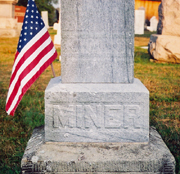 |
| United Brethren Church |
He would walk to and from his home every Saturday and back on Monday…. I know it was hard heavy work. We were at Chopping, Hewing and framing a barn and house. I was assisting in the work. He and his brother were working by the day, and I have no recollection of him loosing any time on account of any sickness.
William suffered from tuberculosis and bronchitis. Fellow soldier Scott remembered that after returning home after the war, he saw William “nearly every day” and that William suffered from "pain and weakeness in his Breast with Cough, loss of Flesh and difficulty of Breathing” and that he would “gradually decline in health and get worse each year…"
Seeking medical treatment, William took palliating medicine prescribed by Jewett physician Dr. McGuire. Rachel assisted with:
... home made remedies … such as cough syrup made of Hoarhound Elecampane Cornfry, wild cherry and spikenard with sugar or honey &c. and a great amount of pattend medicines such as Pisos Cure of Consumption and Jaynes Expectorant for Coughs Consumption and other such remedies; all of which he used – almost constantly from the time of his return from the service … up to nearly about the time of his death…”
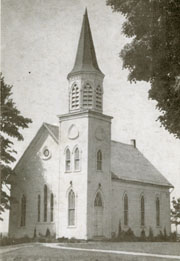 |
| United Brethren Church |
Friend Enoch Bricker recalled that a Dr. Nixon operated on William to relieve suffering caused by hemorrhoids. According to Bricker, "Blood poisoning set in and went clear through his system and that was the direct cause of his death."
William became very ill in November 1880. Rachel later wrote that "He could not lay down. We had to get a sick chair for him. It seemed he could not lie down on account of shortness of breath..."
On Feb. 18, 1881, William passed away at New Rumley, at the age of 51. Dr. D.J. Snyder of Scio attended him in his last sickness.
He was laid to rest in the graveyard of the United Brethren Church in New Rumley.
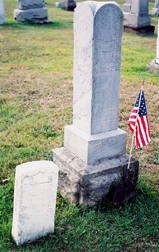 |
| The Miner grave, New Rumley |
After William’s death, the 36-year-old widow Rachel had few financial resources. Said neighbor John Scott, she "has no means of support except what she earns with her hands and by her labor for her neighbors in this village." She successfully applied for a federal pension for her husband’s war service, and received $8 per month. Later, this amount was raised to $12 monthly, then to $20 a month.
Providing testimony on Rachel's behalf were several New Rumley friends and neighbors, including carpenter Enoch Bricker, merchant Thomas H. Cunningham, blacksmith Kennedy Lyons, farmer Daniel Gotshall, shoemaker William G. Grissinger, farmer Henry Kimmel, tailor John A. Scott, carpenter George W. Shultz, mechanic Alex May, carpenter Alexander May. Also testifying were Conotton resident Robert McFarland Scott, Jewett resident Franklin Shilling and Scio carpenter John Knouff.
Rachel spent her remaining 36 years as a widow. She died in New Rumley on Sept. 9, 1917, at the age of 72. Presumably she is buried with her husband, although her name is not marked on any gravestones in the family plot at the United Brethren Church cemetery.
Copyright © 2002, 2004, 2006, 2019 Mark A. Miner
